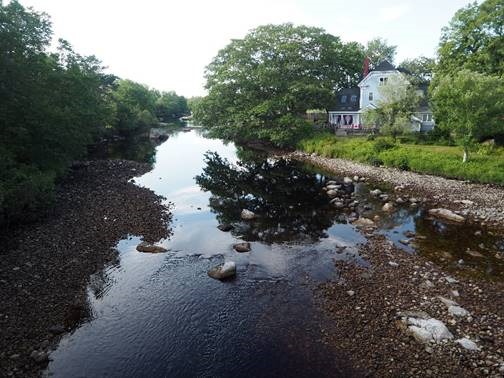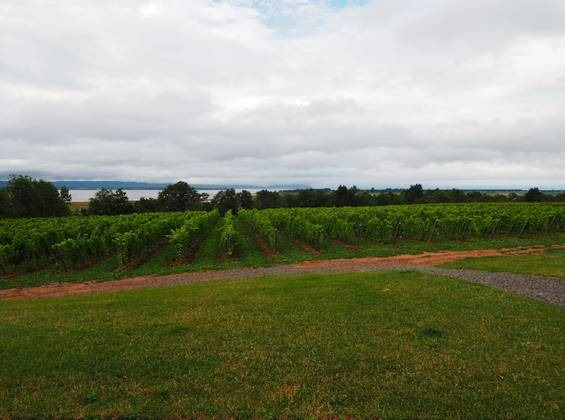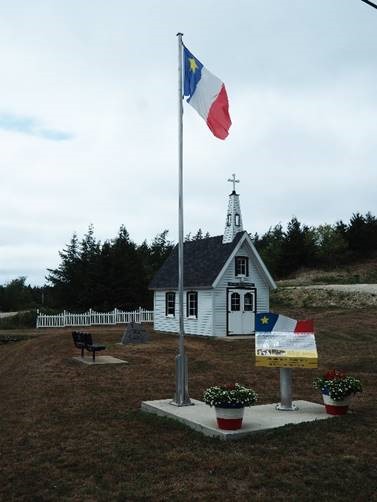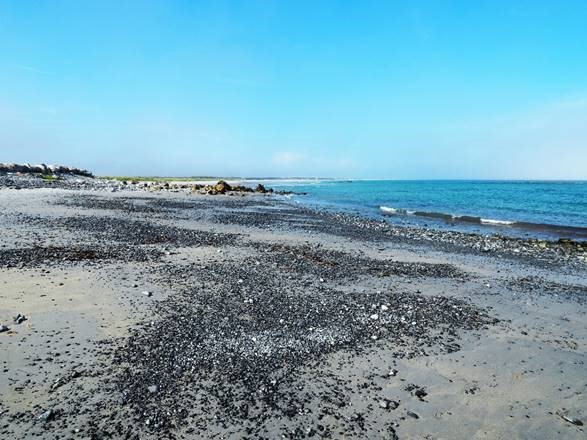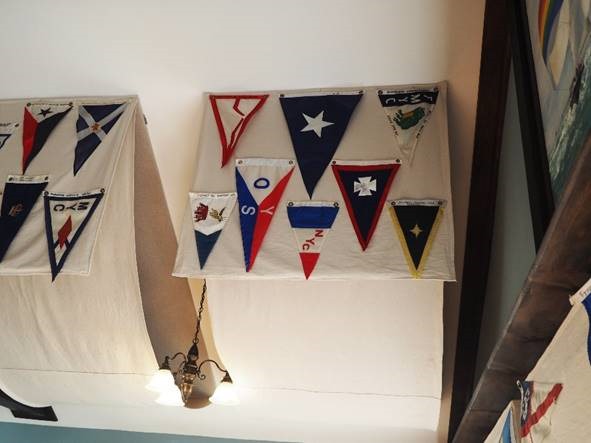15 Aug - exploring Nova Scotia

|
43:50.25N 066:07.5W
Early evening in the Bay of Fundy, Nova Scotia Early one December morning in 1917, two ships collided in the Halifax harbour entrance. Both were running late: the outbound IMO was empty and bound for Belgium to pick up refugees from the Great War. The inbound MONT BLANC was a heavily-laden ammunition ship on her way from New York to join a convoy bound for France. In normal times, the harbour would have been closed to outbound ships when something of this size was coming in; in normal times though, the ammunition ship might not have been allowed in anyway and under modern rules, I doubt whether she would have carried such a dangerous cocktail of 3000 tonnes of flammables and explosives in the same holds. But these were not normal times and the IMO sailed, appearing round a blind bend relatively late. Instead of keeping to the starboard side, IMO had gradually worked her way across to the wrong side of the narrow channel and caused consternation on the bridge of MONT BLANC. Communications between the two ships and harbour authorities were not as good as they would be today and the IMO kept coming, perhaps thinking that there was more water than there actually was. She must have cut across the bows of the MONT BLANC and by the time the team onboard IMO reacted appropriately, a collision was inevitable. It must have happened in slow motion and they hit each other at very slow speed. The high bows of the empty IMO rode over the lower bows of the heavily laden MONT BLANC, toppling barrels of benzol which spilled and was ignited by the sparks as the two steel ships disengaged. Although neither ship was badly damaged, a fire started onboard MONT BLANC which spread quickly. The crew, realising that a major explosion was imminent, abandoned ship. A passing tugboat tried to pass a line and tow the ship into open water but could not get close enough because of the heat. The ship drifted ashore at the industrial end of the city in an area called Richmond. As thousands of people gathered to watch the conflagration, she exploded dramatically. Debris was carried for several miles with the blast wave, a tsunami formed which wrecked several ships in the harbour (including the IMO) and an area of 400 acres was flattened. More than 1600 people died instantly and 9000 were injured, more than 300 of whom later died. Fires started all over the city; many people who had been watching the incident were blinded. The response from ordinary people, the authorities and the international community was almost as remarkable as the incident. The harbour was open for business a week later, a massive programme of public health, transport and construction got underway: this was a long-term project and the Halifax Relief Commission finally wound down in 1976. So on Tuesday 14 August, we visited the Maritime Museum of the Atlantic in Halifax to learn about the disaster. To be honest, we both found the display slightly frustrating as it didn’t tell us quite enough, or lay out events as they occurred with as much clarity as the remarkable 9/11 Museum in New York (see blog dated 27 July 2018). But it certainly captured our imagination. The explosion remains one of the largest and most destructive non-nuclear, man-made explosions ever. Initially the crew of the MONT BLANC were blamed, perhaps because anti-French feeling was running high. Eventually, both ships were found to be at fault, which is probably correct. I think that the harbourmaster should have enforced his rules, the IMO should have waited and the MONT BLANC should have reacted earlier. I understand why they abandoned ship, but I’d like to think that braver men would have tried to turn her away from the city into deeper water. We had to move on though, ironically to catch the tide. We headed north west across Nova Scotia to the top end of the Bay of Fundy and the town of Truro. Here, sandwiched between New Brunswick and Nova Scotia, the narrowing neck of water generates tidal ranges of 16m, reportedly the biggest in the world. I had always thought that the waters south of the Channel Islands and around St Malo in particular had that honour, but the Brittany coast manages a mere 13m!
The Clyde River, Nova Scotia We were not going to marvel at the low water mudflats, but a ‘world famous spectacle’: the ‘tidal bore’ where rivers flow back upstream with the rising tide. The event occurs just after high tide, twice a day and attracts crowds of visitors. We joined a group on the back of the Salmon River at Truro and waited. Braced for the sound of an approaching freight train, flocks of seabirds taking to the skies and a torrent of white water, expectations were quite high. A couple of minutes after the published time of high tide, the seagulls did all get airborne in the magical way that flocks of birds seem to act as one body, but they did a quick circuit and landed again, unperturbed. A few minutes later, as the crowd began to get restless and Julie went for a walk to see if she could find a better observation point, the bore arrived. It was about a foot high and travelled at about 15mph. The waters behind it were quite choppy, but no more than 18 inches high. Where the river narrowed, the water accelerated and you could watch the height rising very quickly. That was the most impressive part: the realisation that this is a natural phenomenon caused by the interaction of earth and moon: King Canute wouldn’t have had a hope here. A phenomenon certainly, rather than a spectacle, and to the cynic, aptly named.
The tidal bore at Truro We went in search of alcohol. We travelled south west along the shores of the Bay of Fundy to the fertile Annapolis Valley, where Canadians make wine. Did you know that Canada is a wine producer? I’m afraid that I did not, but it’s worth noting that this part of Canada is on the same latitude as Bordeaux. We called at the impressive premises of the Lightfoot and Wolfville Winery to enjoy some fine views across the vineyards to the Bay and sampled some of their offerings. The red was decidedly unremarkable, but the whites, based around reisling and chardonnay grapes were rather good. We bought some and looked forward to enjoying them with some local scallops and lobster. Interestingly, they do not export their wines overseas and the enterprise reminded me of the Ironworks distillery in Lunenburg – another example of good quality, small scale activity which lacks the momentum (or the desire?) to grow, perhaps because they enjoy the ‘hands on’ business of producing and shy away from the implications of joining the mass market?
Nova Scotian vineyards – not something you see in Scotland! Now hungry, we went in search of scallops. Enroute, we stopped at the tiny fishing village of Halls Harbour, where the tide was almost impossibly low and the local boats were doing some maintenance. Apparently they used to build boats on the foreshore here in between the high tides, only installing the machinery once they were watertight and would float on the rising water. Our epicurean destination was the ‘scallop capital of Canada’, Digby, another hour or so away. The countryside is still quite flat compared to ‘Old Scotland’, but it’s a very attractive rural landscape, mainly given over to crops and smallholdings. Not as forested as the area around Yarmouth and the southern shores though. We saw it on a grey, rainswept day; in the sunshine it would have been quite beautiful.
Halls Harbour on the Bay of Fundy We reached Digby at sunset and dined at The Wheelhouse seafood restaurant where the dish of the day was scallops, cooked three ways: deep fried, pan fried and wrapped in bacon (er… fried). Here, everything comes with fries, coleslaw and ketchup so it’s not quite the culinary firework show you might expect with such fresh, tasty ingredients. But the pan-fried chaps in particular were delicious and set us up well for the journey back to the boat in the dark and the rain… On the Wednesday, we went south in the car towards Cape Sable and then east to Shelburne. It was foggy, not an unusual state of affairs in Nova Scotia, but our first experience of it since arriving on Saturday. We followed the coast road through Acadia, an area with a strong French heritage and a clear reliance on lobster fishing. Every inlet seemed to host a small, well-equipped harbour packed with strong, well-maintained seagoing lobster boats. No tourism, no recreational boating. Plenty of ‘trucks’ and gardens full of lobster pots – after all, this is the ‘off season’ when lobster fishing is banned in these waters. Every now and again the fog lifted, giving way to bright sunshine and a glorious view. In need of a break from the road, we stopped at Shag Harbour to visit the UFO museum there, which tries to tell the story of a UFO sighting there in the 1960s. Quite a number of different people in different places clearly saw something, but despite extensive searches, nothing was ever found. My theory is that it was some early experimental aircraft from the neighbouring USA, but nobody in authority wanted to admit that it was flying undetected in Canadian airspace… It was unquestionably the dullest museum we have ever visited.
A French Canadian memorial in Acadia, Nova Scotia The beach at Cape Sable more than made up for it though. The sun came out after lunch and we enjoyed a wonderful walk along a fine, deserted stretch of seashore before heading on towards the yachting centre at Shelburne.
Cape Sable, Nova Scotia Shelburne is a logical ‘port of entry’ for cruising yachtsmen coming north from Cape Cod and Maine who want to cruise the beautiful eastern shores of Nova Scotia and beyond. It’s a very pretty harbour with a mix of commercial fishing and yachting and a nice town. We didn’t go there in Escapade because you can’t hire a car there and we wanted to see as much of the province as possible in a very short period. In the yacht club, we found a copy of Peter Loveridge’s ‘Cruising Guide to Nova Scotia’, an invaluable companion for anyone cruising these fascinating waters. It’s self-published and once you start reading, you can guess why – hidden amongst the well-presented, useful data on anchorages and passage making are a myriad of politically incorrect observations that give the book neo-comic status. He needs a good editor! Many yacht clubs carry the burgees from other clubs around the world left by cruising yachtsmen such as ourselves. I’m not well enough organised to have brought a collection to distribute around the North Atlantic, but we were delighted to see a Hornet Services Sailing Club burgee (we have been members since 1986) proudly displayed in the clubhouse. I wonder who that was?
The Hornet Services Sailing Club burgee, proudly flying at Shelburne YC, Nova Scotia |

